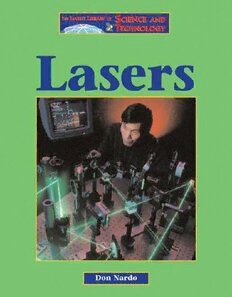
Lasers PDF
Preview Lasers
——————— ——t——“‘ i Boston Public Library Boston, MA 02116 TDP AWN 9 loner the p orgy of the Bost on Public : forary. vale of this material beneiits the Library. e e Digitized by the Internet Archive in 2012 http://archive.org/details/lasersOOnard Lasers Other books in The Lucent Library of Science and Technology include: Black Holes Comets and Asteroids Genetics Global Warming Twe Lucent Lisrary or SCIENCE AND # TECHNOLOGY Lasers by Don Nardo <I LUCENT BOOKS? THOMSON —— ——____—_~ GALE On cover: A scientist focuses intently as he engages in laser research. © 2003 by Lucent Books. Lucent Books is an imprint of The Gale Group, Inc., a division of Thomson Learning, Inc. Lucent Books® and Thomson Learning™ are trademarks used herein under license. For more information, contact Lucent Books 27500 Drake Rd. Farmington Hills, Ml 48331-3535 Or you can visit our Internet site at http:/www.gale.com ALL RIGHTS RESERVED. No part of this work covered by the copyright hereon may be reproduced or used in any form or by any means—graphic, electronic, or mechanical, including photocopying, recording, taping, Web dis- tribution or information storage retrieval systems—without the written permission of the publisher. LIBRARY OF CONGRESS CATALOGING-IN-PUBLICATION DATA Nardo, Don, 1947- Lasers / by Don Nardo. p. cm. — (The Lucent library of science and technology) Summary: Discusses the scientific discovery and development of the use of high-intensity light, called laser, and its use in our daily lives. Includes bibliographical references and index. ISBN 1-59018-104-2 1, Lasers—Juvenile literature. [1. Lasers.] |. Title, II. Series. TA1682 .N36 2003 621,36'6—de21 Printed in the United States of America Table of Contents Foreword Introduction Going Where No One Has Gone Before Chapter 1 The Development of Lasers Chapter 2 Lasers in Science and Industry Chapter 3 Lasers in Communication and Marketing Chapter 4 Military Applications of Lasers Chapter 5 Medical Uses of Lasers Chapter 6 Lasers in Entertainment Chapter 7 The Future of the Laser Notes For Further Reading Works Consulted Index Picture Credits About the Author Foreword — “The world has changed far more in the past 100 years than in any other century in history. The reason is not political or economic, but technological—technologies that flowed directly from advances in basic science.” — Stephen Hawking, “A Brief History of Relativity,” Time, 2000 he twentieth-century scientific and technological revolution that British physicist Stephen Hawking describes in the above quote has transformed virtually every aspect of human life at an unprecedented pace. Inventions unimaginable a century ago have not only become commonplace but are now considered neces- sities of daily life. As science historian James Burke writes, “We live surrounded by objects and systems that we take for granted, but which profoundly affect the way we behave, think, work, play, and in general conduct our lives.” For example, in just one hundred years, transporta- tion systems have dramatically changed. In 1900 the first gasoline-powered motorcar had just been intro- duced, and only 144 miles of U.S. roads were hard- surfaced. Horse-drawn trolleys still filled the streets of American cities. The airplane had yet to be invented. Today 217 million vehicles speed along 4 million miles of U.S. roads. Humans have flown to the moon and commercial aircraft are capable of transporting passen- gers across the Atlantic Ocean in less than three hours. The transformation of communications has been just as dramatic. in 1900 most Americans lived and worked on farms without electricity or mail delivery. Few people had ever heard a radio or spoken on a tele- phone. A hundred years later, 98 percent of American 8
